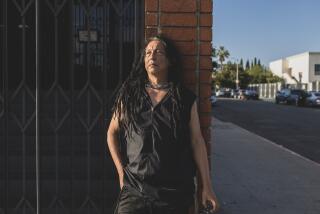Suicide Is Dramatic Finale to Case
- Share via
MIAMI BEACH — Trapped on a moored houseboat by his own notoriety, Andrew Phillip Cunanan committed suicide apparently using the same .40-caliber handgun he used in a nationwide murder rampage, Miami Beach police said Thursday.
Cunanan’s body was pulled from the houseboat early Thursday after a siege by police that began midday Wednesday, ending a manhunt but leaving open a mystery about the motives of a suspect who became America’s most-wanted man.
Authorities noted that the 27-year-old Cunanan, wanted in the murders of five men including fashion designer Gianni Versace, died only four miles from where Versace was gunned down last week.
Paul Philip, FBI agent in charge of the Miami field office, credited a massive police dragnet for keeping the fugitive in the area. “He managed to get 40 blocks--that’s the best he could do in all this time,” said Philip. “I think that’s pretty good.”
Police said they are keeping their homicide investigation open because so many questions remain, including where Cunanan stayed in the days following the Versace killing and what relationship, if any, Cunanan had with the owner of the houseboat, German club owner Torsten Reineck, who reportedly is being sought on fraud and tax evasion charges in Germany.
The FBI said Thursday night that agents had questioned Reineck in Las Vegas Thursday afternoon but provided no details of the session. Reineck owns the Apollo Spa, a gay club, in that city.
Contacts With Friends Investigated
The FBI is also interested in reconstructing Cunanan’s contacts with friends during the time he was being sought. Cunanan called several friends during his 12 weeks on the lam, including one “associate” on the West Coast within 48 hours of Versace’s murder, Deputy FBI Director William J. Esposito said at a press conference in Washington.
The person who received that call, which originated in southern Florida, did not inform the FBI, Esposito said. But in an FBI interview subsequent to the call, he told agents that Cunanan asked about mutual friends on the East Coast who might have a passport that Cunanan could use.
Cunanan, who did not discuss the Versace killing with this person, left no doubt that his intent was to leave the country, Esposito said.
The magnitude of questions left open by Cunanan’s suicide was underscored by the lack of a suicide note. “To date there is no suicide note or other correspondence that would reflect on why he committed these crimes he is accused of,” said Miami Beach police Chief Richard Barreto.
But there is an inescapable bottom line. “All across the nation, our citizens can stand down and breathe a sigh of relief,” said Barreto. “The reign of terror brought upon us by Andrew Cunanan is over.”
Cunanan was on the run from four killings in three states before he allegedly assassinated Versace on July 15 as the wealthy celebrity designer walked up the steps of his South Miami Beach mansion. In Minnesota, Cunanan was charged in the death of a former lover, David Madson, and was suspected of killing Jeffrey Trail, a friend. He also was charged in the death of wealthy Chicago developer Lee Miglin and the killing of New Jersey cemetery caretaker William Reese. Those four killings happened in late April and early May.
Cunanan made the FBI’s most-wanted list on June 12, but it was the murder of Versace that prompted a massive nationwide media and police hunt for him. The search for Cunanan involved “almost 1,000 agents” in the FBI alone, which Esposito equated with the intensity of the hunt for the Unabomber.
Until the Versace slaying, the FBI had “no clue at all” on Cunanan’s whereabouts, Esposito said.
He was an average-looking man known for his ability to blend in with his surroundings, but in recent days “I think he was a desperate person, in a situation where it would be very, very difficult for him to move about,” said Barreto.
Ironically, the man whose image was seen around the world left a corpse that could not be identified by its face. An autopsy performed by the Dade County Medical Examiner said Cunanan committed suicide by shooting himself through the mouth.
The gun was found with the body, which was identified as Cunanan’s by matching a thumbprint taken from his California driver’s license.
The houseboat where Cunanan took his life is docked on a finger of the Intracoastal Waterway, along famed Collins Avenue, just four miles north of the glitzy Art Deco district of south Miami Beach and the elegant villa where Versace, 50, was gunned down in a bold daylight attack.
The dramatic finale to the saga of a fun-loving male prostitute from San Diego who apparently had morphed into a vicious and feared serial killer lifted a shroud of apprehension from people all across the U.S., but especially from those in the gay community.
“It’s unfortunate that the man killed himself, but the past few months have been extremely stressful for our community,” said Darryl Cooper, board member of National Coalition of Anti-Violence Programs. “A lot of our anxieties and concerns have been alleviated.”
Tests Awaited on Possible HIV Infection
Reports from San Diego suggested that Cunanan may have learned he was infected with the AIDS virus before setting off on a series of murders. Authorities were awaiting further autopsy results to determine if Cunanan carried the virus.
Although both Versace and Cunanan were gay, there is no firm evidence they knew each other or ever met.
“The Versace family is relieved and grateful to those who helped resolve the terrible murder of Gianni Versace and the other victims,” said the family in a statement.
And although U.S. Atty Gen. Janet Reno on Thursday lauded the work of law enforcement agents and thanked the thousands of citizens who called with possible sightings of Cunanan, in the end it seemed to be blind luck that led to the drama’s denouement.
A caretaker checking Reineck’s shuttered blue and white houseboat found a door ajar and noticed something inside had been moved when he stopped by to check on the premises about 4 p.m. Wednesday. As the caretaker retreated, he told police, he heard a gunshot.
Within minutes, dozens of flak-jacketed SWAT team officers had swarmed around the boat, even covering possible avenues of escape by water in what is called Indian Creek. Rush-hour traffic was blocked for hours as news media helicopters overhead broadcast the siege live.
After lobbing several canisters of tear gas into the houseboat, a team of officers rushed into the residence about 8 p.m. They found a body on a bed on the second floor. It was early Thursday before they could officially confirm that it was Cunanan.
During the almost two months he was believed to have been in Miami Beach, Cunanan may never have left the island, or indeed, ever wandered farther than along a six-mile strip of hotels, condominiums, shops and restaurants between Versace’s house and the commercial neighborhood near the hotel where he stayed.
‘We Were Never That Close to Cunanan’
Shortly after Versace’s slaying, police found nearby the stolen truck of murder victim William Reese, and immediately made Cunanan the prime suspect in Versace’s murder. But “it is my understanding that we were never that close to Mr. Cunanan,” said the FBI’s Philip.
Police declined comment on reports that in the eight days since Versace was slain, Cunanan may have been living in one or more of several boats docked along Collins Avenue in an area known for its posh condominiums and fancy resort hotels.
Barreto said there was no sign of forced entry into the houseboat where Cunanan died. Philip added that Cunanan had access to water and electricity in the houseboat, but said: “I don’t know what he was eating in there.”
Neither Philip nor Barreto would supply any details about what Cunanan had in his possession when he died, what he was wearing, or the scene inside the boat, which is a 3,500-square-foot residence with a two-story cathedral-ceilinged living room, and staircases to two large bedrooms.
Cunanan’s last known residence was the Normandy Plaza Hotel, a 1930s-era hotel in a somewhat-seedy section of Collins Avenue near 71st Street. He registered there in May under an alias.
Miriam Hernandez, 56, the Normandy’s manager, remembers Cunanan as one of the most polite and neatest tenants she has ever had. “He was a handsome man, a sweet person with a beautiful smile,” said Hernandez, who saw Cunanan almost daily for the seven weeks or more that he lived at the hotel. “When the guy starts talking to you, you like the guy,” she said.
Reserved and soft-spoken, Cunanan didn’t speak much, however, rarely if ever making conversation with other hotel guests, most of them long-term residents.
He also was obsessively neat. Although Hernandez saw him carrying take-out food--sub sandwiches, Kentucky Fried Chicken, McDonald’s--into his room many evenings, no trash was ever left in his room. Each night, apparently, Cunanan carried the detritus of his meal to the dumpster in the alley beside his hotel.
He discouraged maid service and even seemed not to care about fresh towels, said Hernandez’s brother Alberto, who lives on the same floor of the hotel and works as a housekeeper.
Although many in the neighborhood now recall seeing him walking Collins Avenue--always dressed in shorts, a T-shirt, ball cap and sandals, carrying a backpack--he attracted little attention. But on July 7, he did leave his mark--and his thumbprint--when he hocked a gold coin at the Cash on the Beach pawn shop on 71st Street.
“‘Why are you giving me so little when it cost me so much?” pawnshop clerk Vivian Oliva recalled Cunanan asking her when she offered him $190 for the coin. Police believe Cunanan stole the coin from Miglin, the developer Cunanan is believed to have tortured and killed in Chicago.
Oliva said Cunanan did not hesitate when she told him he would have to leave a thumbprint, or blink when she said that if he did not claim the coin in 90 days, it could be sold. “Don’t worry,” Oliva quoted Cunanan as telling her, “I’m going to come back for it.”
Cunanan skipped out of the Normandy quietly, in the early morning hours of July 12 before Miriam Hernandez came in to work. Cunanan put the key on the dresser, left the door open and apparently walked out the rear of the hotel toward the beach.
He owed one day’s rent--$35.73, including tax.
In the room that day, Alberto Hernandez said he found a stack of fashion and automobile magazines and an old, rusted hair clipper, which he put in a plastic trash bag and tossed in the dumpster.
“I think he had changed his look, and he didn’t want us to see him,” said Miriam Hernandez. “When I called him the day before to tell him the rent was due, he said he was leaving and asked if he could pay me the next day.
“I said, ‘I enjoyed your stay. You are a very nice man.’ ”
Times staff writers Ronald J. Ostrow and Heather Knight in Washington, Tom Gorman in Riverside and researcher Anna M. Virtue in Miami contributed to this story.
More to Read
Sign up for Essential California
The most important California stories and recommendations in your inbox every morning.
You may occasionally receive promotional content from the Los Angeles Times.










